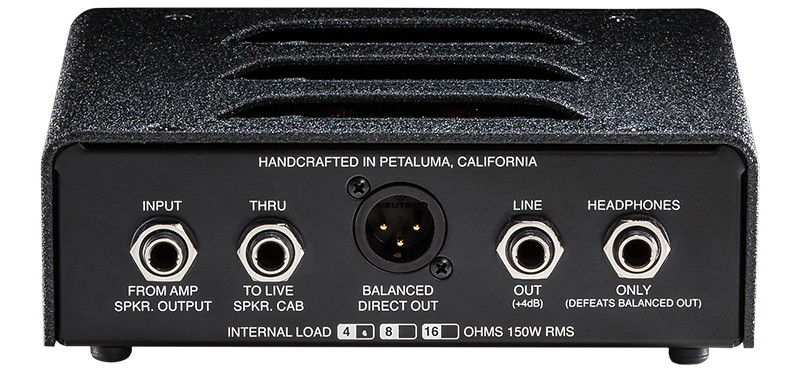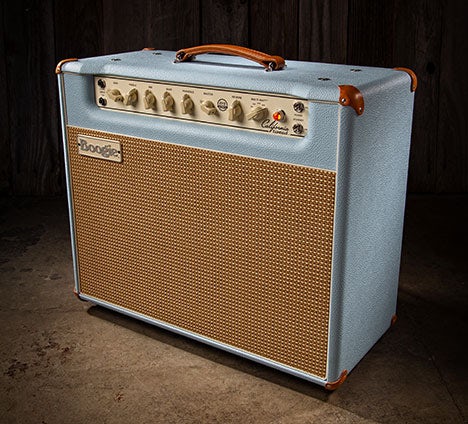Amplitudes: The Mesa Boogie Blog

Tones And Tips, Guitar Products
Optimizing your tone with the CabClone™
In production for over a year now, the MESA/Boogie® CabClone™ has found it’s way into many player’s gigs, recording studios, jam rooms and bedrooms with a thoughtful feature set for dealing with a variety of real-world playing, recording and gigging scenarios where a mic isn’t an option or for when it’s desirable to capture a direct signal while also capturing a mic’d signal. The following discussion is meant to clear up some misconceptions, provide some answers to commonly asked questions and help you attain the very best results from this passive, hardware (not software based) analog device.
Some background on direct boxes
Direct boxes have been around for decades and it’s the internal circuitry, particularly the components that EQ the final output, that sets one direct box apart from another. While there are many ways to record direct these days, if you want to use YOUR favorite amp without a microphone, options are quickly narrowed and you’ll begin to look at features among available models and whether or not your needs justify the added expense that these features typically add. Some devices offer minimal options for capturing your signal while others offer many more features and range in price running up to $1000 or more.
The CabClone is part of a class of passive devices, meaning you do not need additional power supplies or power cables to ”power it up”. It treats the signal through a series of components that roll off unwanted frequencies and shape the sound through subtraction – as opposed to “Active” devices that shape sound with additive changes derived through increases in gain in specific frequencies.
Those require a power supply to run the operational-amplifiers (chips) that provide the possibility of adding gain in specific regions of the circuit. In the passive CABCLONE, cabling from an amplifier’s SPEAKER output is all you need to connect and the small AC signal that normally goes to the speaker is the feed to the Speaker Simulation circuitry. Clean, simple, effective. However, passive designs have limitations and the extreme shaping required to create sounds associated with some musical styles may be more easily found in some Active Direct devices.
We chose the passive approach for several reasons that include; ease of use, signal purity, retail price point, size, no need for AC Power and associated cabling, and ultimately… to offer OUR take on a class of products (Analog Passive DI Speaker Simulators) that have been popular for thirty years and served many guitarists well.
We DID NOT design the CABCLONE to replace microphones or compete with Active Analog DI Speaker Simulators or Software Based Modeling, IR (Impulse Response) Soft and Hardware, Profiling or any other digital method of capturing and/or treating amplified guitar sounds.

The impact of using a CabClone or any passive direct box
Let’s review what is actually happening if you want to record direct with your amp. You’re removing the speakers, the cabinet design, microphones and the limitless sonic choices there, the room, and most importantly, the physical dynamics that occur between your amp and you! This is a lot of the signal chain to remove from the process! So it must be said… if you are after the richest tone you can possibly get with your amp of choice, and you have the time, mics, great room and freedom to make substantial “noise”… using a microphone may be the way to go. BUT…If mics aren’t possible or practical in your situation (and there are many different scenarios and reasons why… we’ll discuss some later), then the CABCLONE is one simple to use, neutral sounding, affordable option that has a very small footprint. It can deliver very good to great results fast and with minimal setup depending on your recording experience, adeptness with EQ and skill in the final mixing process.
Comparing raw “untreated” (not EQ’d) output from direct boxes to a live microphone environment does not make sense
Microphones perform a basic function of picking up sound and converting that sound into a signal that can be captured or amplified in different formats. While there are myriad microphone options, brands, styles, applications, and sounds to choose from in the world of mics, they all provide that similar function. Yet each offers something very specific or unique in terms of response and EQ curve and those signature responses have, in many cases, become accepted as “classic” or “standards”. Here is what you need to consider with a direct box.

The impact of EQ
As we mentioned, the impact of a microphone is ultimately the addition of a personalized, unique EQ that affects what you hear and what you feel. It’s no different with a direct box like the CabClone, except that the output of the device is created from a source with reduced dynamics…remember all those elements we left out of the signal chain?
Consequently, to achieve results more similar to what a microphone listening to all those missing elements captures, you need to look elsewhere for the “magic sauce” that those elements would impart on the sound. Things like possibly more EQ in specific regions at the Console or DAW, perhaps adding outboard compression to give the sound a softer, more “squishy feel” like a speaker cabinet and finally signal processing, especially delay and reverb, to increase the depth, spatial quality and “bloom” of the sound.
Comparisons between the CabClone and microphones are misleading if you consider what the CabClone can do for you, since you’re probably going to use it in situations where it’s not convenient, or you prefer not to, use a microphone.
The same holds true in situations where you want to blend the CABCLONE with a mic’d cabinet, because there, you WANT the focus, increased articulation and clarity a direct signal can provide. There are many times when this “drier”, tighter version of the sound can really help add definition to a part when it’s blended right.
If you’re recording at home by yourself, in a full live band situation (a particularly great application for the CabClone), playing a gig with your amp’s sound going to a PA… when using the CabClone or any direct box, you will – almost without question – EQ your sound just like you would with a microphone (although probably using a different EQ curve overall).
In a recording environment, you would normally dial in the tone of your amp –using a mic (or mics) and apply the desired EQ curve and signal processing to achieve what you wanted to hear in headphones or the control room before hitting record. The same process applies with a DI/Speaker Simulation device like the CabClone. However, while offering a similar function as a microphone in that it captures the sound–albeit in a different way from an earlier spot in the signal chain–it offers a very different, more neutral, less scooped (in most cases) voice. This requires, you guessed it… a different approach regarding EQ. More times than not… more of it, in more places. Like seasonings on bland food, this treatment, and substitutes for the missing elements in the signal chain, can be critical to achieving great results.



